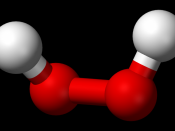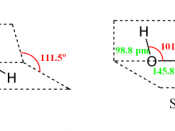An investigation to compare the reaction rates between potato and hydrogen peroxide against liver and hydrogen peroxide through loss in mass.
Background information:
Catalase is an enzyme that is found in all cells. This means that it is an intracellular enzyme. And enzyme is a biological catalyst. A catalyst is some thing that speeds up a reaction without being changed itself. Because of this enzymes and catalysts can be used again and again. Enzymes are protein chains that have a primary, secondary and tertiary structure. Their primary structure shows the order and types of amino acids used to form the protein chain. The secondary structure shows the basic folding of the protein and is held in place by hydrogen bonds. The tertiary structure shows a more complex folding which gives it its globular shape. The tertiary folding of the enzyme also gives it its active site. The active sit of an enzyme is the part of the enzyme that determines what the enzyme will react with.
If this active site is destroyed in any way the enzyme is said to be denatured and will no longer work. Certain things affect the reaction rate of a substance where an enzyme is used. The concentration of the reactant will affect the reaction rate. If there is a strong concentration of reactant or catalase then there will be a faster reaction rate than if the concentration was weak. Also, the higher the temperature of the substance the faster the reaction rate will be. This also applies to the surface area of the cells containing the catalase. If the cells have a large area the reaction rate will be very fast. This is because more catalase will be exposed to the reactant and this will mean that more products are being made in a...



Hypothesis
Seriously I liked your lab report, but in your hypothesis u did not follow the method of If...Then...Because. Also u used lost of personal nouns, such as "I" if u wanna write a hypothesis it should be clear of these nouns. Overall your hypothesis was clear and deep. And thanks again.
0 out of 0 people found this comment useful.